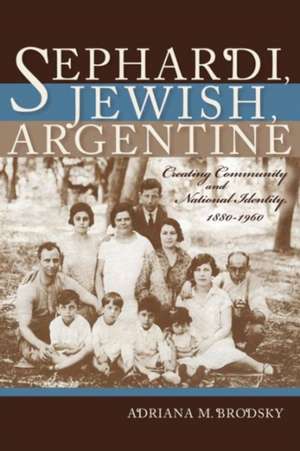Sephardi, Jewish, Argentine: Indiana Series in Sephardi and Mizrahi Studies
Autor Adriana M. Brodskyen Limba Engleză Hardback – 20 noi 2016
At the turn of the 20th century, Jews from North Africa and the Middle East were called Turcos ("Turks"), and they were seen as distinct from Ashkenazim, not even identified as Jews. Adrian M. Brodsky follows the history of Sephardim as they arrived in Argentina, created immigrant organizations, founded synagogues and cemeteries, and built strong ties with coreligionists around the country. She theorizes that fragmentation based on areas of origin gave way to the gradual construction of a single Sephardi identity, predicated both on Zionist identification (with the State of Israel) and "national" feelings (for Argentina), and Sephardic Jews assumed leadership roles in national Jewish organizations. Rather than assume that Sephardi identity was fixed and unchanging, Brodsky highlights the strategic nature of this identity, constructed both from within the various Sephardi groups and from the outside, and reveals that Jewish identity must be understood as part of the process of becoming Argentine.
Preț: 503.30 lei
Preț vechi: 653.63 lei
-23% Nou
96.31€ • 100.89$ • 79.82£
Tipărit la comandă
Livrare economică 09-23 aprilie
Specificații
ISBN-10: 0253022711
Pagini: 256
Dimensiuni: 152 x 229 x 18 mm
Greutate: 0.5 kg
Editura: Indiana University Press
Seria Indiana Series in Sephardi and Mizrahi Studies
Notă biografică
Adriana M. Brodsky is Associate Professor of History at St. Mary's College of Maryland. She is editor (with Raanan Rein) of The New Jewish Argentina: Facets of Jewish Experiences in the Southern Cone, winner of the Latin American Jewish Studies Association Best Book Award in 2013.
Cuprins
Note about Translation and Transliteration
Acknowledgements
Introduction
1. Burying the Dead: Cemeteries, Walls and Jewish Identity in Early-Twentieth-Century Argentina
2. Helping the Living: Philanthropy and the Boundaries of Sephardi Communities in Argentina
3. The Limits of Community: Unsuccessful Attempts at Creating Single Sephardi Organizations
4. Working for the Homeland: Zionism and the Creation of an "Argentine" Sephardi Community after 1920
5. Becoming Argentine, Becoming Jewish, Becoming and Remaining Sephardi: Jewish Women and Identity in Twentieth-Century Argentina
6. Marriages and Schools: Living within Multiple Borders
Postscript
Notes
Bibliography
Index


